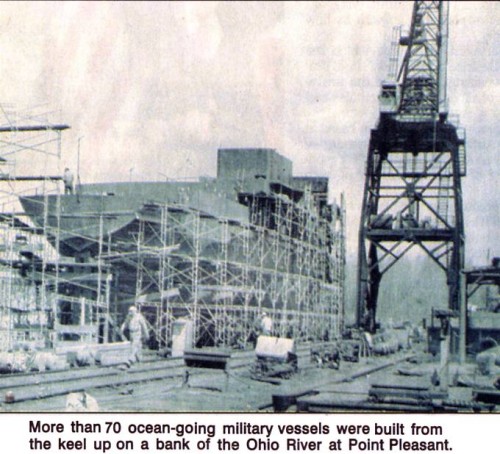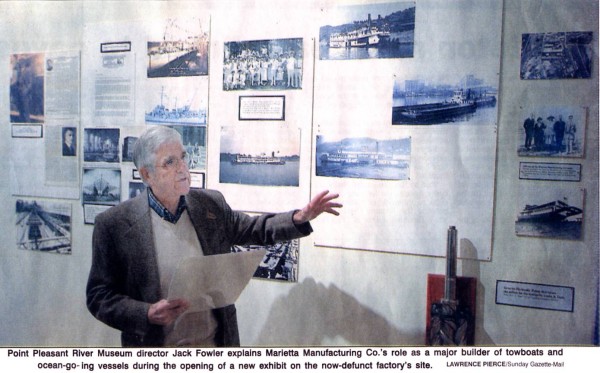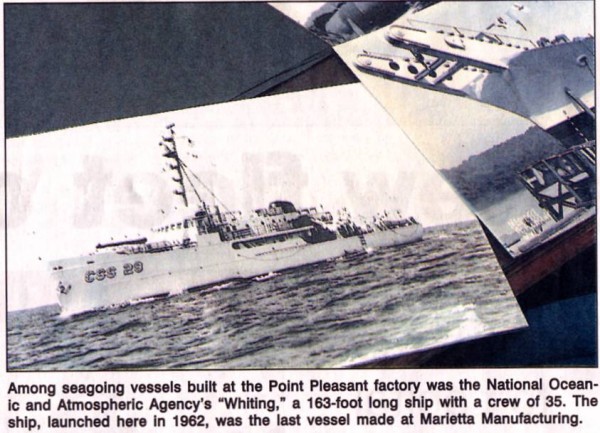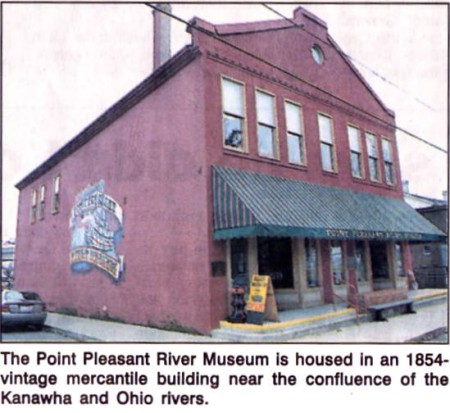
Sunday Gazette-Mail
5 February 2006
By Rick Steelhammer
rsteelhammer@wvgazette.com
POINT PLEASANT - Although hundreds of miles from the nearest seaport, more than 70 ocean-going military vessels were built on a riverbank in this Mason County town and launched into the Ohio River to begin cruises that took them around the world.

Ships built by an army of skilled craftsmen at the Marietta Manufacturing Co. plant went on patrol for Nazi submarines along the Atlantic Coast, delivered ammunition and supplies along Vietnam's Perfume River, and located the wreckage of John F. Kennedy Jr.'s ill-fated airplane off the coast of Massachusetts.
Some have left their military careers behind and are still sailing, including two former Coast Guard patrol ships that now carry tourists around New York Harbor.

"At one point, the workers here were building a new mine planter every 16 days," said Jack Fowler, director of the Point Pleasant River Museum. "Between 1,800 and 2,000 people worked at Marietta Manufacturing during World War II. When a shift change rolled around, the streets of Point Pleasant turned into one big traffic jam."
The legacy of the Marietta Manufacturing plant and its employees is the subject of a special two-month exhibit that opened last week at the Point Pleasant River Museum.
It includes film footage of a typical plant workday and of several launching ceremonies, numerous photos of ships and boats made at the plant, a scale model of the now-defunct factory at its peak, a roster of employees, and an assortment of artifacts from the manufacturing complex.

Marietta Manufacturing relocated to Point Pleasant in 1915 from a flood-prone site in Marietta, Ohio, and started out building stoves, soon expanding to include marine navigation components, then the boats themselves.
Before it closed its doors in 1970, factory workers built more than 145 vessels. The 73 military craft built here include mine planters, patrol boats, anti-torpedo-net tenders, landing craft (LCUs), and oceanic re-search ships.
Civilian vessels launched here include 30 sternwheel towboats, four sidewheel dredges, 53 steam tugs and six screw-driven towboats, many of which still toil on the nation's inland waterways.
"The Marietta plant started out with sternwheelers in the '20s, moved into Coast Guard cutters in the '30s, then mine-planters in the '40s, LCUs in the '50s and survey ships in the '60s," said Fowler, whose father was Marietta's production superintendent.
The last ship produced by the factory was the National Oceanographic and Atmospheric Agency survey ship "Whiting," launched in November 1962. The 163-foot research vessel and its sister ship, the "Pierce," launched the previous year are among the largest vessels built at Marietta Manufacturing.
"I remember playing in the high school band during a christening ceremony in 1962 that must have been for the Whiting," said River Museum staffer Ruth Fout. "I remember being very impressed when I saw a lady break a bottle of champagne on the boat."
The museum has made an effort to compile histories for the Point Pleasant-built vessels, and several of them have had illustrious careers.
The USS Nike and the USS Nemesis, both launched in 1934, began their careers as large cruising cutters for the U.S. Coast Guard, but transferred to Navy ownership one month before the attack on Pearl Harbor. At the start of the U.S. entry into World War II, the Nike and Nemesis accounted for two of only three warships assigned to patrol the Florida Coast, a section of the Gulf of Mexico, and the waters surrounding Cuba and the Bahamas for German U-boats.
The Nike was patrolling off the coast of Delaware in early 1942 when she rescued 40 survivors of a torpedoed freighter. A few days later, off the coast of Maryland, the vessel rescued the entire 38-man crew of a torpedoed American tanker.
The Nike and the Triton, another former Coast Guard cutter made by Marietta Manufacturing, are now part of the Circle Line fleet, taking tourists on sightseeing tours of New York Harbor.
Between February and August 1942, the Nemesis rescued 55 survivors from a pair of torpedoed tankers and launched five attacks on suspected submarine positions in Florida's Gulf Coast area.
After returning to duty as a Coast Guard cutter at the end of the war, the Nemesis was de-commissioned in the 1960s and converted into a floating restaurant called the "Ancient Mariner" in Fort Lauderdale, Fla. When the restaurant closed in 1986, the ship was sold to a dive club and made a part of an artificial reef off the Florida coast.
The USS Elder, built here in 1941, tended anti-submarine nets at Allied bases across the South Pacific. At the end of World War II, the Elder hosted a diving operation in Caballo Bay, near the island of Corregidor in Philippines, where millions of dollars worth of silver pesos had been dumped to prevent seizure by the Japanese during the opening months of the war.
Most of the 10 LCU (landing craft utility) vessels made at Point Pleasant in the 1950s saw "Brown Water Navy" duty during the Vietnam War as river-going cargo and troop carriers.
The NOAA research vessel Whiting produced hydrographic charts from Lake Superior to the coast of Honduras, and in 1999, located the wreckage of John F. Kennedy Jr.'s plane off the Massachusetts Coast, and the wreckage of Egypt Air Flight 990 off the coast of Rhode Island.
The sidewheel steam dredge Capt. Meriwether Lewis, built here in 1932, now serves as the Army Corps of Engineers Museum of Missouri River History at a mooring in Brownville, Neb.
The Point Pleasant River Museum, now in its second full year of operation, is housed in a brick, 1854-vintage former mercantile establishment facing Tu-Endie-Wei State Park
The only river-themed museum in the state, its hands-on displays include a working pilothouse, a steam calliope and compressed-air whistle.
Exhibits cover such topics as Native-American life along the Ohio and Kanawha rivers, early European settlements, improvements in river navigation, river accidents and disasters, and the 1967 Silver Bridge disaster.
"We think we tell a pretty good story about the river's role as a highway," said Fowler. "But we've still got a lot to do to get to where we want to be."
While about 8,000 guests visited the museum last year, "our goal is to have 20,000 to 25,000," Fowler said. "That will help us make it self-sustaining."
The museum has applied for grants that will allow it to build a hands-on virtual-reality pilot-house, in which visitors will work authentic controls to guide a simulated towboat's passage through a stretch of river. An-other grant would allow the museum to build and interpret an aquarium displaying fish and other river creatures from the Ohio and Kanawha rivers.

The Point Pleasant River Museum, at 28 Main Street, is open Tuesdays through Fridays from 10 a.m. to 3 p.m.; on Saturdays from 11 a.m. to 4 p.m.; and on Sundays from 1 to 5 p.m. Ad-mission is $4 for adults and $1 for children in grades 1-12.
To contact staff writer Rich Steelhammer, use e-mail or call 348-5169.